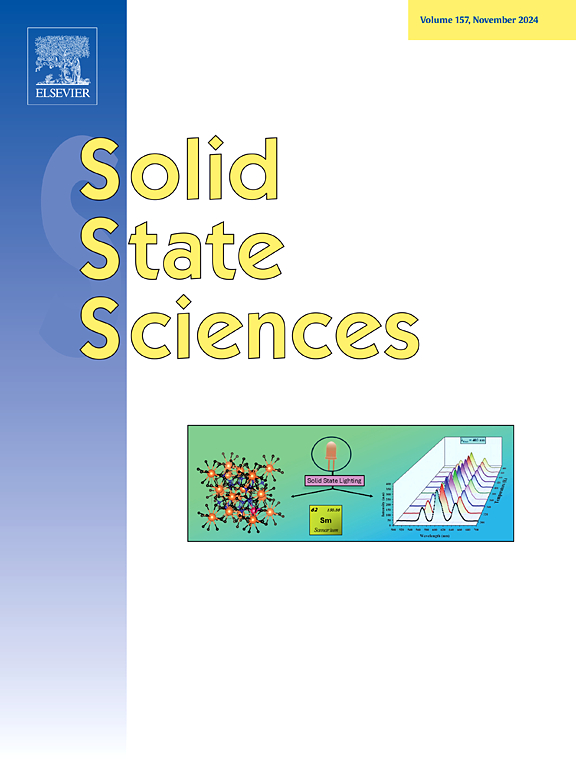五氧化二钒纳米纤维在碳纳米纤维垫上的水热生长:一种固态不对称超级电容器的阳极材料
IF 3.4
3区 化学
Q2 CHEMISTRY, INORGANIC & NUCLEAR
引用次数: 0
摘要
超级电容器具有高功率密度、快速充放电、长循环寿命等优点,是一种极好的储能解决方案。然而,超级电容器的主要技术问题是能量密度低。一个潜在的解决方案是开发能储存更多能量的先进电极材料。在这项研究中,我们通过水热法在纳米碳纤维(CNFs)垫上生长了一维五氧化钒纳米纤维(VNFs)。形态学研究表明,复合材料由vnf和CNFs的夹层结构组成,具有较大的表面积和大量的孔隙,有利于高效的离子传递和电子运动,对高电容具有重要意义。此外,在中性电解质(如Na2SO4和Li2SO4)中,氧化还原活性vnf和多孔CNFs的伪电容和双电层电容(EDLC)的协同组合在0.1 a /g下分别产生700.1和615.2 F/g的高电容。采用VNF/CNF混合垫作为阳极,活性炭布作为阴极,负载Na2SO4或li2so4的聚乙烯醇(PVA)膜作为电解质兼分离器,构建了柔性原型超级电容器。这些ASC器件分别使用Na2SO4和li2so4电解质提供了72.51和51.83 Wh/kg的高能量密度,优于先前报道的使用各种V2O5/C阳极制成的ASC器件。基于pva的膜电解质为asc提供了出色的弯曲稳定性和防泄漏特性,这对柔性和可穿戴电子产品至关重要。本文章由计算机程序翻译,如有差异,请以英文原文为准。

Hydrothermal growth of vanadium pentoxide nanofibers on carbon nanofiber mat: An anodic material for solid-state asymmetric supercapacitors
A supercapacitor is an excellent energy storage solution due to its high-power density, rapid charge and discharging, and long cycle life. However, the main technical issue with supercapacitors is low energy density. One potential solution is to develop advanced electrode materials that store more energy. In this study, we have grown 1D vanadium pentoxide nanofibers (VNFs) on a carbon nanofibers (CNFs) mat via a hydrothermal approach. The morphological study showed that the hybrid mat consists of a sandwich structure of VNFs and CNFs with a large surface area and plenty of pores, which facilitates efficient ion transport and electron movement important for high capacitance. Furthermore, a synergistic combination of pseudo-capacitance and electrical double layer capacitance (EDLC) from redox active VNFs and porous CNFs produces high capacitances of 700.1 and 615.2 F/g at 0.1 A/g in neutral electrolytes such as Na2SO4 and Li2SO4, respectively. A flexible prototype supercapacitor was constructed using a VNF/CNF hybrid mat as an anode, activated carbon cloth as a cathode, and a Na2SO4 or Li2SO4-loaded polyvinyl alcohol (PVA) membrane as an electrolyte-cum-separator. These ASC devices delivered high energy density of 72.51 and 51.83 Wh/kg with Na2SO4 and Li2SO4-based electrolytes, respectively, which are superior to those obtained from previously reported ASCs made with various V2O5/C anodes. The PVA-based membrane electrolytes provide excellent bending stability and leakage-proof features to ASCs, which are critical to flexible and wearable electronics.
求助全文
通过发布文献求助,成功后即可免费获取论文全文。
去求助
来源期刊

Solid State Sciences
化学-无机化学与核化学
CiteScore
6.60
自引率
2.90%
发文量
214
审稿时长
27 days
期刊介绍:
Solid State Sciences is the journal for researchers from the broad solid state chemistry and physics community. It publishes key articles on all aspects of solid state synthesis, structure-property relationships, theory and functionalities, in relation with experiments.
Key topics for stand-alone papers and special issues:
-Novel ways of synthesis, inorganic functional materials, including porous and glassy materials, hybrid organic-inorganic compounds and nanomaterials
-Physical properties, emphasizing but not limited to the electrical, magnetical and optical features
-Materials related to information technology and energy and environmental sciences.
The journal publishes feature articles from experts in the field upon invitation.
Solid State Sciences - your gateway to energy-related materials.
 求助内容:
求助内容: 应助结果提醒方式:
应助结果提醒方式:


